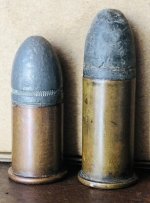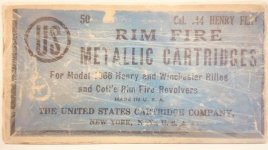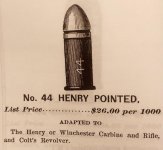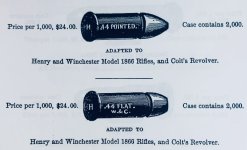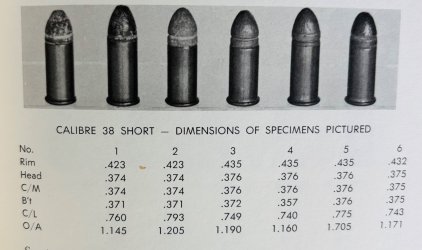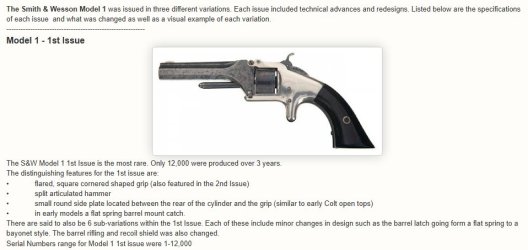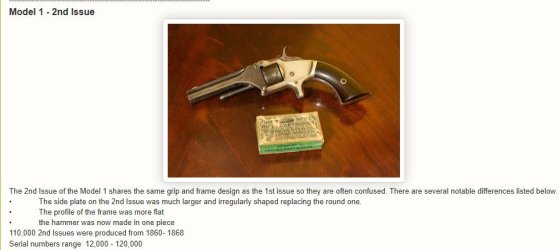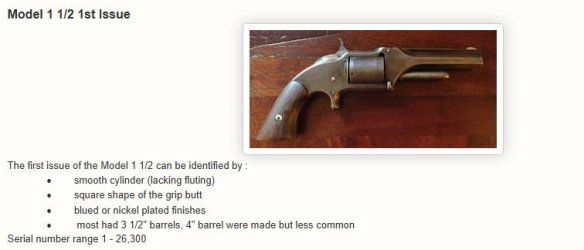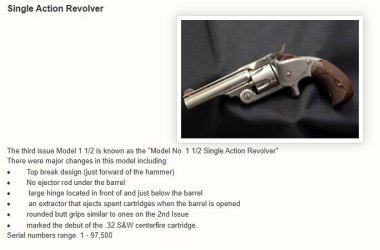The Smith & Wesson 1-1/2 2nd Model revolvers represent a pivotal evolution in American firearms history. Manufactured during the late 19th century, these compact, top-break revolvers were widely embraced by civilians and military users for their ease of use, solid construction, and innovative features. They also mark the era when Smith & Wesson was actively patenting and refining mechanisms that would define revolver technology for decades.
The following U.S. patent dates commonly appear on these models, illustrating the progression of revolver innovation:
- January 17 & 24, 1865 – Introduced the top-break frame and automatic cartridge ejection system.
- July 11, 1865 – Covered improvements to lockwork and cylinder operation.
- August 24, 1869 – Signaled major frame and durability upgrades, closely tied to the larger Model 3.
- July 25, 1871 – Likely a refinement or reissue of previous designs to enhance production and strength.
- May 11, 1880 – Corresponds to advances in extraction systems and structural reinforcement for use with stronger cartridges.
The 1-1/2 2nd Model was part of S&W's small-frame revolver line and was chambered in several rimfire calibers:
- .22 Short Rimfire – Popular for target shooting and discreet personal carry.
- .38 Rimfire – Offered more stopping power while retaining a compact form.
- .44 S&W Flat Rimfire (aka .44 S&C) – Found in related large-frame models like the Model 3, used in military service and frontier settings.
- Bullet diameter: ~0.222 in (5.64 mm)
- Case diameter: ~0.226 in (5.74 mm)
- Rim diameter: ~0.275 in (6.99 mm)
- Case length: 0.43 in (10.9 mm)
- Overall length: 0.69 in (17.5 mm)
- Bullet diameter: ~0.375 in (9.53 mm)
- Case diameter: ~0.380 in (9.65 mm)
- Rim diameter: ~0.435 in (11.05 mm)
- Case length: ~0.88 in (22.4 mm)
- Overall length: ~1.26 in (32.0 mm)
- Bullet diameter: ~0.446 in (11.33 mm)
- Case diameter: ~0.471 in (11.96 mm)
- Rim diameter: ~0.622 in (15.80 mm)
- Case length: 0.91 in (23.1 mm)
- Overall length: ~1.37 in (34.8 mm)
This particular revolver is serial-numbered 88720, which appears both:
- On the butt of the frame (grip area)
- On the underside of the barrel catch – a key feature of the safety hammerless top-break design
The presence of matching serial numbers on both parts is a strong indicator of factory-original configuration, increasing both the collectibility and historical authenticity of the piece.
The S&W 1-1/2 2nd Model is a landmark firearm for several reasons:
- Early adopter of metallic cartridge firing
- Breakthrough top-break design with automatic ejection
- Rimfire calibers spanning civilian to military usage
- Strong patent lineage showcasing 15+ years of mechanical refinement
- Matching serial numbers reinforce originality and collector value
This model reflects the transitional period between percussion cap pistols and modern revolvers. It was durable, innovative, and practical — a favorite among 19th-century shooters.
To research this specific revolver further, use the serial number in conjunction with patent dates and frame style to pinpoint its production range. Resources like the Standard Catalog of Smith & Wesson, the USPTO Patent Archive, and historical firearm forums can offer deeper insight.
Leave the screws as-is, even if they're slightly damaged, mismatched, or buggered — here's why:
- Originality adds value: Collectors often prefer a gun in "as-found" condition, with all its original parts, even if they're imperfect.
- Patina & age tell a story: Wear and damage are part of the revolver's history. Replacing parts — especially visible ones like screws — can diminish the authenticity and period-correct appearance.
- Matching metal finish: Original screws often have a different heat treatment and aging compared to modern replacements. New screws may stand out visually, especially if blued or polished differently.
Recommended if:
- You're keeping the revolver as a collector's piece.
- It's not mechanically compromised or unsafe to handle.
- You value originality and provenance.
Replacing damaged screws is reasonable if they are severely stripped, missing, or interfere with safe operation or disassembly:
- Jack First Inc. is a trusted supplier of high-quality reproduction parts. Their screws are often very close to original specs, but may need minor fitting.
- You could age or antique the new screws to better match the revolver's finish (e.g., with cold blue or rust browning).
- Keep the originals in a labeled bag if you ever want to restore the gun to "as-found" condition.
Shop the latest Vintage Replacement Smith & Wesson Top-break .32 revolver Parts

jackfirstinc.com
Recommended if:
- The screw heads are stripped to the point of being unusable.
- You're planning a sympathetic restoration for display or occasional function.
- The revolver is incomplete and you're aiming for visual or mechanical completeness.
If the screws are not structurally critical, consider:
- Leaving them in place for now and sourcing correct replacements just in case.
- Photographing and cataloging the original condition before any restoration steps.
- If you replace them, store the originals with the gun.
This gives you flexibility — you can always undo a reversible change like replacing screws.
If you do replace screws, try to:
- Use correct head styles and thread types for the period.
- Avoid over-torquing or forcing modern screws into old threads — this can damage the frame or grip screw holes.
- If unsure, consult a vintage S&W gunsmith or restorer.

